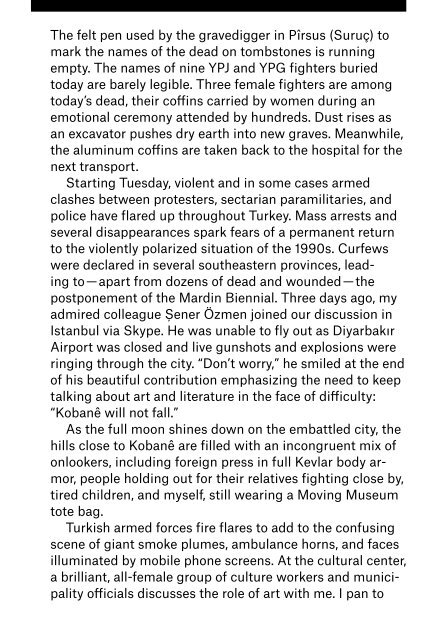Stateless Democracy
1RHiH4Y
1RHiH4Y
Create successful ePaper yourself
Turn your PDF publications into a flip-book with our unique Google optimized e-Paper software.
The felt pen used by the gravedigger in Pîrsus (Suruç) to<br />
mark the names of the dead on tombstones is running<br />
empty. The names of nine YPJ and YPG fighters buried<br />
today are barely legible. Three female fighters are among<br />
today’s dead, their coffins carried by women during an<br />
emotional ceremony attended by hundreds. Dust rises as<br />
an excavator pushes dry earth into new graves. Meanwhile,<br />
the aluminum coffins are taken back to the hospital for the<br />
next transport.<br />
Starting Tuesday, violent and in some cases armed<br />
clashes between protesters, sectarian paramilitaries, and<br />
police have flared up throughout Turkey. Mass arrests and<br />
several disappearances spark fears of a permanent return<br />
to the violently polarized situation of the 1990s. Curfews<br />
were declared in several southeastern provinces, leading<br />
to — apart from dozens of dead and wounded — the<br />
postponement of the Mardin Biennial. Three days ago, my<br />
admired colleague Șener Özmen joined our discussion in<br />
Istanbul via Skype. He was unable to fly out as Diyarbakır<br />
Airport was closed and live gunshots and explosions were<br />
ringing through the city. “Don’t worry,” he smiled at the end<br />
of his beautiful contribution emphasizing the need to keep<br />
talking about art and literature in the face of difficulty:<br />
“Kobanê will not fall.”<br />
As the full moon shines down on the embattled city, the<br />
hills close to Kobanê are filled with an incongruent mix of<br />
onlookers, including foreign press in full Kevlar body armor,<br />
people holding out for their relatives fighting close by,<br />
tired children, and myself, still wearing a Moving Museum<br />
tote bag.<br />
Turkish armed forces fire flares to add to the confusing<br />
scene of giant smoke plumes, ambulance horns, and faces<br />
illuminated by mobile phone screens. At the cultural center,<br />
a brilliant, all-female group of culture workers and municipality<br />
officials discusses the role of art with me. I pan to<br />
frame resident refugees observing F-16 jets circling above.<br />
What is the task of art in times of emergency?<br />
— Pîrsus (Suruç), on the morning of 10 October, 2014<br />
(with Savaş Boyraz, Leyla Toprak, Salih Șahin)<br />
Hito Steyerl is a visual artist, documentary filmmaker, and writer. This<br />
text was first published as an announcement on e-flux on 10 October<br />
2014. It appears here with the permission of the author and e-flux.



